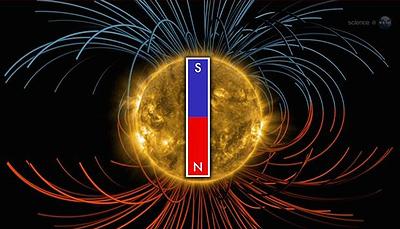Sun’s Magnetic Field Forecast to Flip by Year End
STANFORD, California, August 6, 2013 (ENS) – The Sun’s giant magnetic field is forecast to reverse itself sometime in November or December with consequences for the entire solar system, according to measurements from NASA-supported observatories. Such solar disturbances can cause geomagnetic storms in Earth’s magnetic field, affecting communications, power lines and satellites.
“It looks like we’re no more than three to four months away from a complete field reversal,” says solar physicist Todd Hoeksema of Stanford University. “This change will have ripple effects throughout the solar system.”
Hoeksema is the director of Stanford’s Wilcox Solar Observatory, one of the few observatories in the world that monitor the Sun’s polar magnetic fields. The Wilcox Solar Observatory began daily observations of the Sun’s global magnetic field in May 1975, with the goal of understanding changes in the Sun and how those changes affect the Earth; this is now called space weather.
The Sun’s magnetic field changes polarity approximately every 11 years. It happens at the peak of each solar cycle as the Sun’s inner magnetic dynamo re-organizes itself, explains NASA’s Dr. Tony Phillips. “The coming reversal will mark the midpoint of Solar Cycle 24. Half of ‘Solar Max’ will be behind us, with half yet to come.”
Solar activity, such as sunspots and coronal mass ejections, increases during solar maximum, resulting in more active space weather around Earth,
When coronal mass ejections hit the Earth they can affect the Earth’s magnetic field, said NASA’s Dr. Eric Christian during the last solar reversal 11 years ago. “This change in the magnetic field can cause back-currents in power lines that have caused power failures like the one in Montreal. They can also degrade oil pipelines, cause increased atmospheric drag on satellites, disrupt communications, and the particles can even directly harm satellite electronics or astronauts,” he said.
These outbursts can happen at any time, but the biggest ones, which do the most damage, tend to happen when the Sun is at the maximum of its variable intensity every 11 years.
Just as Earth scientists watch our planet’s polar regions for signs of climate change, solar physicists do the same thing for the Sun. Magnetograms at Wilcox have been tracking the Sun’s polar magnetism since 1976, and they have recorded three grand reversals, with a fourth coming before year’s end.
Astronomers at the Wilcox Solar Observatory monitor the Sun’s global magnetic field on a daily basis. Stanford University operates Wilcox, with all funding currently provided by NASA.
Solar physicist Phil Scherrer, also at Stanford, describes what happens, “The Sun’s polar magnetic fields weaken, go to zero, and then emerge again with the opposite polarity. This is a regular part of the solar cycle.”
A reversal of the Sun’s magnetic field is, literally, a big event, says NASA. The domain of the Sun’s magnetic influence, also known as the “heliosphere,” extends billions of kilometers beyond Pluto. Changes to the field’s polarity ripple all the way out to the Voyager probes, on the doorstep of interstellar space.
When solar physicists talk about solar field reversals, their focus often centers on the “current sheet,” a surface jutting outward from the Sun’s equator where the Sun’s slowly-rotating magnetic field induces an electrical current.
The current itself is small, only one ten-billionth of an amp per square meter (0.0000000001 amps/m2), but the amperage flows through a region 10,000 kilometers thick and billions of kilometers wide. Electrically speaking, the entire heliosphere is organized around this enormous sheet.
During field reversals, the current sheet becomes very wavy. Scherrer says that as the Earth orbits the Sun, our planet dips in and out of the current sheet.
Transitions from one side of the current sheet to another can stir up stormy space weather around the Earth.
Cosmic rays are also affected. These are high-energy particles accelerated to nearly light speed by supernova explosions and other violent events in the galaxy. Cosmic rays are a danger to astronauts and space probes, and some researchers say they might affect the cloudiness and climate of Earth.
The current sheet acts as a barrier to cosmic rays, deflecting them as they attempt to penetrate the inner solar system. A wavy, crinkly sheet acts as a better shield against these energetic particles from deep space.
As the field reversal approaches, data from Wilcox Solar Observatory show that the Sun’s two hemispheres are out of synch.
“The Sun’s north pole has already changed sign, while the south pole is racing to catch up,” says Scherrer. “Soon, however, both poles will be reversed, and the second half of Solar Max will be underway.”
Copyright Environment News Service (ENS) 2013. All rights reserved.
http://ens-newswire.com/2013/08/06/suns-magnetic-field-forecast-to-flip-by-year-end/

